|
 |
|
 |
|
|
 |
|  |
|
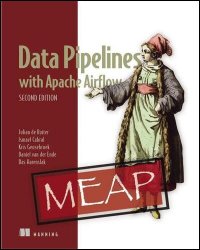 Название: Data Pipelines with Apache Airflow, Second Edition (MEAP v9) Название: Data Pipelines with Apache Airflow, Second Edition (MEAP v9)
Автор: Julian de Ruiter, Ismael Cabral, Kris Geusebroek, Daniel van der Ende, Bas Harenslak
Издательство: Manning Publications
Год: 2025
Страниц: 401
Язык: английский
Формат: pdf (true), epub
Размер: 56.2 MB
Simplify, streamline, and scale your data operations with data pipelines built on Apache Airflow. Apache Airflow provides a batteries-included platform for designing, implementing, and monitoring data pipelines. Building pipelines on Airflow eliminates the need for patchwork stacks and homegrown processes, adding security and consistency to the process. Now in its second edition, Data Pipelines with Apache Airflow teaches you to harness this powerful platform to simplify and automate your data pipelines, reduce operational overhead, and seamlessly integrate all the technologies in your stack. This book focuses on Apache Airflow, a batch-oriented framework for building data pipelines. Airflow’s key feature is that it enables you to easily build scheduled data pipelines using Python, while also providing many building blocks that allow you to stitch together the many different technologies encountered in modern technological landscapes. For DevOps, data engineers, Machine Learning engineers, and sysadmins with intermediate Python skills. | |
Разместил: Ingvar16 27-04-2025, 19:02 | Комментарии: 0 | Подробнее
| | | |
 |
|  |
 |
|
 |
|
|
 |
|  |
|
 Название: Learn Docker in a Month of Lunches, Second Edition (MEAP v4) Название: Learn Docker in a Month of Lunches, Second Edition (MEAP v4)
Автор: Elton Stoneman
Издательство: Manning Publications
Год: 2025
Страниц: 537
Язык: английский
Формат: pdf (true)
Размер: 73.2 MB
Just the Docker you need to know in 22 bite-sized lessons! No matter what role you have in IT, you’re likely to touch Docker at some point. Whether you’re deploying a pre-built application, creating a secure test environment, or packaging components in a microservices system, Docker provides a straightforward system for bundling all the pieces together in a safe, portable “container” you can drop wherever it’s needed. In this freshly-revised bestseller, Docker expert Elton Stoneman guides through using containers for cloud migration, microservices, and handling legacy systems–all in 22 short lessons you can complete on your lunch break. The samples are all guaranteed to work on any Linux, Windows, or Mac system. You’ll explore building and running Docker apps in Go, Java, Node, and .NET, adding observability with monitoring dashboards, running databases in containers, running containers in the cloud, and migrating legacy systems to Docker. There's even a primer on using Kubernetes to manage your containers! For readers from any technical background—developers, admin, and DevOps all welcome! | |
Разместил: Ingvar16 27-04-2025, 18:24 | Комментарии: 0 | Подробнее
| | | |
 |
|  |
 |
|
 |
|
|
 |
|  |
|
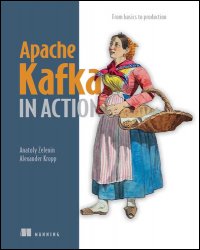 Название: Apache Kafka in Action: From basics to production Название: Apache Kafka in Action: From basics to production
Автор: Alexander Kropp, Anatoly Zelenin
Издательство: Manning Publications
Год: 2025
Страниц: 370
Язык: английский
Формат: pdf (true)
Размер: 68.0 MB
Apache Kafka, start to finish. Apache Kafka in Action: From basics to production guides you through the concepts and skills you’ll need to deploy and administer Kafka for data pipelines, event-driven applications, and other systems that process data streams from multiple sources. Authors Anatoly Zelenin and Alexander Kropp have spent years using Kafka in real-world production environments. In this guide, they reveal their hard-won expert insights to help you troubleshoot common Kafka challenges. Delving deeper into the various aspects of development for Kafka would fill an entire book, but because this book isn’t a developer’s guide, we’ll only briefly go into the most important details. For the sake of clarity, we mostly use Python in our code examples. In Java and other programming languages, the basic concepts for communicating with Kafka are very similar. For IT operators, software architects and developers. No experience with Kafka required. | |
Разместил: Ingvar16 27-04-2025, 17:49 | Комментарии: 0 | Подробнее
| | | |
 |
|  |
 |
|
 |
|
|
 |
|  |
|
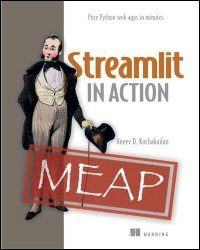 Название: Streamlit in Action: Pure Python web apps in minutes (MEAP v6) Название: Streamlit in Action: Pure Python web apps in minutes (MEAP v6)
Автор: Aneev D. Kochakadan
Издательство: Manning Publications
Год: 2025
Страниц: 445
Язык: английский
Формат: pdf (true), epub
Размер: 42.7 MB
Build amazing web apps with Streamlit and Python! The Streamlit framework empowers Python developers to build web applications quickly without writing a single line of HTML, CSS, or jаvascript. Streamlit in Action lays out everything you need to quickly transform your app ideas into fully-fledged web applications using nothing but Python and your imagination. There’s no need to switch stacks just to add a web front-end to a Python application. This easy to use, lightweight toolkit is perfect for putting a friendly UI on an AI model or creating an interactive data dashboard. Streamlit in Action teaches you how to build great web and front-ends using the Streamlit framework and Python. You'll start with the basics by creating a password validator and a simple to-do list app. Then, you’ll progressively build your skills all the way to developing an executive dashboard, an AI chatbot, and an LLM-based searchable knowledge base. You’ll love the crystal-clear explanations and the interesting hands-on projects as you develop your Streamlit skills step by step. For Python programmers. No web app or AI skills required. | |
Разместил: Ingvar16 27-04-2025, 16:47 | Комментарии: 0 | Подробнее
| | | |
 |
|  |
 |
|
 |
|
|
 |
|  |
|
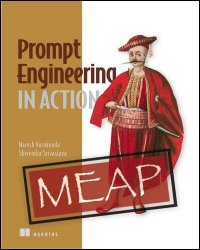 Название: Prompt Engineering in Action (MEAP v4) Название: Prompt Engineering in Action (MEAP v4)
Автор: Naresh Vurukonda, Shivendra Srivastava
Издательство: Manning Publications
Год: 2025
Страниц: 244
Язык: английский
Формат: pdf (true), epub
Размер: 21.1 MB
Tested techniques for writing excellent AI prompts! Each LLM seems to have a mind of its own, and it can be challenging to get the exact results you want. Prompt Engineering in Action teaches you to write prompts that generate the text and code you want, regardless of the LLM you choose. In it, you’ll discover structured and reusable prompt patterns that reduce hallucinations, customize LLMs to specific tasks, and improve the quality of your code generation. Prompt Engineering in Action teaches universal prompting principles, each illustrated with concise examples of a prompt in action. You’ll find more than just simple prompt-and-response methods. It goes beyond the basics of prompting to explore reusability, scaling for prompts, and managing stochastic responses. Dive into prompt patterns such as Persona, Game-Play, and Recipe patterns, and into emerging techniques such as Retrieval-Augmented Generation (RAG) and dynamic agents. You’ll soon be building solutions that are efficient, accurate, and highly adaptable for real-world applications. For readers familiar with the basics of working with LLMs. | |
Разместил: Ingvar16 27-04-2025, 16:22 | Комментарии: 0 | Подробнее
| | | |
 |
|  |
 |
|
 |
|
|
 |
|  |
|
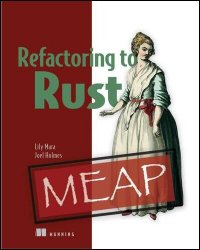 Название: Refactoring to Rust (MEAP V10) Название: Refactoring to Rust (MEAP V10)
Автор: Lily Mara, Joel Holmes
Издательство: Manning Publications
Год: 2025
Страниц: 365
Язык: английский
Формат: pdf (true), epub
Размер: 17.1 MB
Get the speed and reliability of Rust libraries, functions, and high-performance features through incremental adoption without rewriting your codebase from scratch. Refactoring to Rust teaches you how to take advantage of Rust’s easy-to-use interoperating mechanisms. Learn practical code-mixing techniques like embedding Rust libraries into apps written in other languages. This practical guide emphasises techniques for incrementally refactoring performance-critical code to Rust while keeping the rest of your application in its original language. Refactoring to Rust teaches you to combine your favorite programming language with high-performance Rust code. You’ll augment programs with Rust hands-on with approachable examples like solving FizzBuzz with Rust’s pattern matching and gaining enormous runtime speedups to Python code. When you’re done, you’ll have mastered techniques for building Rust plugins you can apply to all kinds of existing software, from games to data tools. | |
Разместил: Ingvar16 27-04-2025, 15:56 | Комментарии: 0 | Подробнее
| | | |
 |
|  |
 |
|
 |
|
|
 |
|  |
|
 Название: Machine Learning for C# Developers: Build smart applications with ML.NET (MEAP V03) Название: Machine Learning for C# Developers: Build smart applications with ML.NET (MEAP V03)
Автор: Fiodar Sazanavets
Издательство: Manning Publications
Год: 2025
Страниц: 198
Язык: английский
Формат: pdf (true), epub
Размер: 24.1 MB
Create production quality Machine Learning models in C# without leaving the .NET ecosystem. Machine Learning for C# Developers teaches you how to build powerful Machine Learning (ML) models using your C# and .NET skills—no Python required! You’ll learn how to use the innovative ML.NET framework to build a virtual assistant that can recognize objects, classify software errors, estimate salaries from a job description, and more. Machine Learning for C# Developers opens up the world of Machine Learning to C# and .NET developers. In it, you’ll find full coverage of the new ML.NET framework that’s at the forefront of Microsoft’s AI developments. Through careful, step-by-step guidance you’ll learn how to deliver everything from simple machine learning tools to complex Deep Learning models—no Python required. | |
Разместил: Ingvar16 27-04-2025, 15:24 | Комментарии: 0 | Подробнее
| | | |
 |
|  |
 |
|
 |
|
|
 |
|  |
|
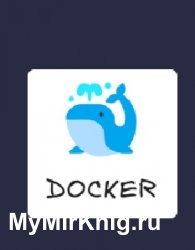
Название: Docker простым языком
Автор: Матвей Чудневцев, Михаил Новичихин
Издательство: Stepik
Год: 2025
Формат: PDF
Страниц: 415
Размер: 26 Mb
Язык: Русский
Мы создали этот курс, потому что многие разработчики и администраторы слышат о Docker как о чем-то очень полезном, но не понимают, как он на самом деле работает и почему стал стандартом в индустрии.
| |
Разместил: Chipa 27-04-2025, 09:37 | Комментарии: 0 | Подробнее
| | | |
 |
|  |
 |
|
 |
|
|
 |
|  |
|
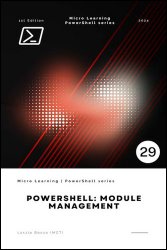 Название: PowerShell: Module Management Название: PowerShell: Module Management
Автор: Laszlo Bocso
Издательство: Independently published
Год: November 8, 2024
Страниц: 277
Язык: английский
Формат: pdf, epub, mobi
Размер: 10.1 MB
"PowerShell: Module Management" is the definitive guide for IT professionals, system administrators, and developers looking to master the art of creating, managing, and distributing PowerShell modules. This comprehensive book takes you on a journey from understanding the basics of PowerShell modules to implementing advanced techniques for module development and deployment. PowerShell is more than just a scripting language; it is a versatile automation platform. The knowledge you gain from this book will enable you to harness the full power of PowerShell modules, transforming how you approach scripting and automation in your professional and personal projects. A PowerShell module is a package that contains PowerShell members, such as cmdlets, functions, variables, and aliases. Modules encapsulate these resources into reusable units, making it easier to organize and share PowerShell code. They can be thought of as libraries or packages in other programming languages, providing a way to extend PowerShell's functionality and create custom toolsets. | |
Разместил: Ingvar16 27-04-2025, 04:51 | Комментарии: 0 | Подробнее
| | | |
 |
|  |
 |
|
 |
|
|
 |
|  |
|
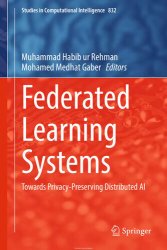 Название: Federated Learning Systems: Towards Privacy-Preserving Distributed AI Название: Federated Learning Systems: Towards Privacy-Preserving Distributed AI
Автор: Muhammad Habib ur Rehman, Mohamed Medhat Gaber
Издательство: Springer
Серия: Studies in Computational Intelligence
Год: 2025
Страниц: 179
Язык: английский
Формат: pdf (true), epub
Размер: 19.3 MB
This book dives deep into both industry implementations and cutting-edge research driving the Federated Learning (FL) landscape forward. FL enables decentralized model training, preserves data privacy, and enhances security without relying on centralized datasets. Industry pioneers like NVIDIA have spearheaded the development of general-purpose FL platforms, revolutionizing how companies harness distributed data. Alternately, for medical AI, FL platforms, such as FedBioMed, enable collaborative model development across healthcare institutions to unlock massive value. Research advances in PETs highlight ongoing efforts to ensure that FL is robust, secure, and scalable. Looking ahead, Federated Learning could transform public health by enabling global collaboration on disease prevention while safeguarding individual privacy. From recommendation systems to cybersecurity applications, FL is poised to reshape multiple domains, driving a future where collaboration and privacy coexist seamlessly. | |
Разместил: Ingvar16 27-04-2025, 02:35 | Комментарии: 0 | Подробнее
| | | |
 |
|  |
|